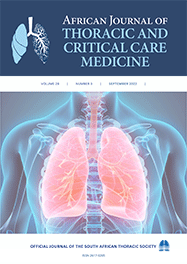Original research

Aetiology and presentation of childhood pleural infections in the post-pneumococcal conjugate vaccine era in South Africa
Abstract
Background. Complications of respiratory infections including pleural effusion (PE) are associated with a high morbidity. Differentiating between PE caused by Mycobacterium tuberculosis (Mtb) infection and other bacterial infections in endemic areas is difficult in children, thus, impacting treatment.
Objective. To investigate the aetiology of PE and features distinguishing tuberculosis (TB) from bacterial PE in children.
Methods. We conducted a prospective study in children with PE admitted to a tertiary hospital in Cape Town from December 2017 to December 2019. Clinical information and routine laboratory investigations were compared between children with bacterial, Mtb or unclassified PE, categorised according to study definitions.
Results. A total of 91 patients were included in the present study and their median age was 31 months (interquartile range (IQR) 11.8 - 102.1). The aetiology was bacterial in 40% (n=37), Mtb in 39% (n=36) and unclassified in 20% (n=18) of patients. Staphylococcus aureus was the most common bacterial isolate, confirmed in 65% (n=24/37) patients, and Streptococcus pneumoniae was confirmed in only 8% of patients. TB was microbiologically confirmed in 33% (n=12/36) of patients. Patients with TB were older (91.6 v. 11.8 months; p<0.001), with more weight loss (28 v. 12 patients; p<0.001), and longer cough duration (10 v. 4 days; p<0.001) than those with other bacterial PE. In contrast, the latter had significantly higher serum C-reactive protein (median 250 v. 122 mg/L; p<0.001), procalcitonin (11 v. 0.5 mg/L; p<0.001), pleural fluid lactate dehydrogenase (7 280 v. 544 U/L; p<0.001), and adenosine deaminase levels (162 v. 48 U/L; p<0.001) and lower glucose levels (1.3 v. 4 mmol/L; p<0.001).
Conclusion. Post 13-valent pneumococcal conjugate vaccine, S. aureus is the dominant cause of PE in children using traditional culture methods, while Mtb remains a common cause of PE in our setting. Useful clinical and laboratory differences between Mtb and other bacterial PE were identified, but the cause of PE in 20% of children was underdetermined. Molecular testing of pleural fluid for respiratory pathogens may be useful in such children.
Authors' affiliations
L Golden, Department of Paediatrics and Child Health, University of Cape Town and Red Cross War Memorial Children’s Hospital, Cape Town, South Africa
S Chaya, Department of Paediatrics and Child Health, University of Cape Town and Red Cross War Memorial Children’s Hospital, Cape Town, South Africa; MRC Unit for Child and Adolescent Health, University of Cape Town, South Africa
K Reichmuth, Department of Paediatrics and Child Health, University of Cape Town and Red Cross War Memorial Children’s Hospital, Cape Town, South Africa
A Visagie, Department of Paediatrics and Child Health, University of Cape Town and Red Cross War Memorial Children’s Hospital, Cape Town, South Africa
A Ayuk, Department of Paediatrics and Child Health, University of Cape Town and Red Cross War Memorial Children’s Hospital, Cape Town, South Africa
S Kwarteng Owusu, Department of Paediatrics and Child Health, University of Cape Town and Red Cross War Memorial Children’s Hospital, Cape Town, South Africa; Komfo Anokye Teaching Hospital, Department of Child Health, Kwame Nkrumah University of Science and Technology, Kumasi School of Medicine and Dentistry, Ghana
D Marangu, Department of Paediatrics and Child Health, University of Cape Town and Red Cross War Memorial Children’s Hospital, Cape Town, South Africa; Kenyatta National Hospital, Department of Paediatrics and Child Health, University of Nairobi, Kenya
N Affendi, Department of Paediatrics and Child Health, University of Cape Town and Red Cross War Memorial Children’s Hospital, Cape Town, South Africa; Department of Paediatrics, Hospital Sultanah Nur Zahirah, Terengganu, Malaysia
A Lakhan, Department of Paediatrics and Child Health, University of Cape Town and Red Cross War Memorial Children’s Hospital, Cape Town, South Africa
D Gray, Department of Paediatrics and Child Health, University of Cape Town and Red Cross War Memorial Children’s Hospital, Cape Town, South Africa
A Vanker, Department of Paediatrics and Child Health, University of Cape Town and Red Cross War Memorial Children’s Hospital, Cape Town, South Africa
H Zar, Department of Paediatrics and Child Health, University of Cape Town and Red Cross War Memorial Children’s Hospital, Cape Town, South Africa; MRC Unit for Child and Adolescent Health, University of Cape Town, South Africa
M Zampoli, Department of Paediatrics and Child Health, University of Cape Town and Red Cross War Memorial Children’s Hospital, Cape Town, South Africa
Full Text:
Cite this article
Article History
Date published: 2022-02-01
Article Views
Full text views: 182
Refbacks
- There are currently no refbacks.
African Journal of Thoracic and Critical Care Medicine| Online ISSN: 2617-0205
This journal is protected by a Creative Commons Attribution - NonCommercial Works License (CC BY-NC 4.0) | Read our privacy policy.
Our Journals: South African Medical Journal | African Journal of Health Professions Education | South African Journal of Bioethics and Law | South African Journal of Child Health | Southern African Journal of Critical Care | African Journal of Thoracic and Critical Care Medicine| South African Journal of Obstetrics and Gynaecology |



.jpg)